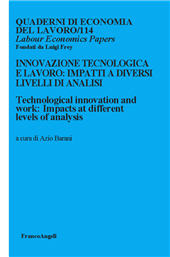Innovazione tecnologica e lavoro agile : quadro evolutivo, dimensioni di sostenibilità e profili organizzativi
187-256 p.
Dopo la crisi pandemica sono sempre più le aziende che stanno pensando di utilizzare lo smart working come modalità di lavoro vera e propria e non più solo come modalità necessaria in periodo di emergenza sanitaria. Occorre quindi agire sulla transizione verso la nuova normalità, ma per farlo è necessario lavorare su tre direttrici: culturale, tecnologica e normativa. Questo saggio ha l'obiettivo di analizzare il fenomeno dello smart working non solo per quanto concerne il risultato finale, ovvero l'implementazione di questo modello lavorativo, ma anche le fasi che ne precedono l'attuazione in azienda o nelle pubbliche amministrazioni.
Verranno affrontati vari aspetti di questa modalità di lavoro: partendo dall'aspetto più generale e normativo, si passerà alla definizione dei pilastri su cui si fonda, all'analisi dello scenario italiano rispetto a quello europeo e alla definizione dei vantaggi e degli svantaggi derivanti, fino ad arrivare alla descrizione delle fasi necessarie alla sua efficace ed efficiente implementazione organizzativa. [Testo dell'editore].
After the pandemic crisis, more and more companies are thinking of using smart working as a real way of working and no longer just as a necessary mode in a period of health emergency. It is therefore necessary to act on the transition towards the new normal, but to do so it is necessary to work on three guidelines: cultural, technological and regulatory. This essay aims to analyze the phenomenon of smart working not only with regard to the final result, that is the implementation of this working model, but also the phases that precede its implementation in the company or in public administrations.
Various aspects of this way of working will be addressed: starting from the more general and regulatory aspect, we will move on to the definition of the pillars on which it is based, to the analysis of the Italian scenario compared to the European one and to the definition of the resulting advantages and disadvantages, up to the description of the phases necessary for its effective and efficient organizational implementation. [Publisher's text].
Fa parte di
Quaderni di economia del lavoro : 114, 2, 2021-
Articoli dello stesso fascicolo (disponibili singolarmente)
-
Informazioni
Codice DOI: 10.3280/QUA2021-114007
ISSN: 1971-8470
MATERIE
PAROLE CHIAVE
- smart working, sostenibilità, cultura organizzativa, implementazione organizzativa
- smart working, sustainability, organizational culture, organizational implementation


